Suppression of the environmental risks of lead in cropland soil using biomass ash and its modified product†
Abstract
In this work, modified biomass ash (MA), obtained through the hydrothermal treatment technique with biomass ash (BA) and alkaline phosphate as raw materials, was used as a useful soil amendment to reduce the environmental risk of lead and was compared with raw ash. In order to confirm the composition changes from BA to MA, the materials before and after modification were characterized by using transmission electron microscopy (TEM), energy dispersive spectroscopy (EDS), Fourier transform infrared (FT-IR) spectroscopy, and X-ray diffraction (XRD). Subsequently, the suppression of the environmental risks of lead in the contaminated cropland soil by MA and BA was systematically investigated through pH evaluation, toxicity-extraction, and fractional analysis. The results show that needle-like hydroxyapatite nanoparticles were generated during the modification process of BA. After incubation with 5% BA and 5% MA for 60 days, the pH of soil samples increased from 5.46 to 7.20 and 6.83, respectively; the lead concentration by TCLP extraction decreased by about 52.6% and 95.2%, respectively. And the content of lead bound to RES increased from 36.28% to 49.09% and 59.58%, respectively. MA showed higher immobilization efficiency, better immobilization stability, and less disturbance to the soil pH than BA, and it can suppress the environmental risk of lead below the standard toxicity level. These results undoubtedly demonstrate that BA has great potential in the practical application of remediation of lead contaminated soil, and its modified product may become a useful amendment to suppress and/or eliminate the high environmental risk of lead by transforming industrial waste into useful nanomaterials for green environmental chemistry.



 Please wait while we load your content...
Please wait while we load your content...